I did read other questions related to "Def Con", but, 1. I did not understand very well what was said, 2. other circuits were not discrete transistor circuits, and 3. I thought that it might be useful to have a minimal circuit with this problem, in case LTSpice can be enhanced to avoid this problem.
The progress message at the bottome left of the screen keeps alternating between the "Def Con" message:
and a message that says that the rate of simulation is in the femtosecond range:
In the above screen shot, please note that progress has slowed to 22.4748 femtoseconds per second of simulation speed forward progress.
I am using LTSpice to try out every combination of NPN in the following circuit, which simply represents a flying capacitor transferring charge between a simple cell and an inductor, lighting an LED. The circuit is an inverting boost topology.
Many transistor combinations run fine. The problem is, for certain combinations of transistors, the (to me) dreaded "Def Con" happens, with progress slowing down to the rate of femtoseconds per second at times.
The circuit as pictured descends into this degenerative condition. One laptop descends to femtoseconds-per-second simulation speed, and another laptop only seems to go down to picoseconds-per-second simulation velocity.
I usually just change the circuit a bit, and the problem goes away, or I find something that was wrong with the circuit, but I don't think I can follow that heuristic here. I would really like to understand how this happens to various Joule Thief circuits and other simple transistor circuits that I am trying on my way towards teaching myself discrete transistor circuitry.
My circuits usually have a left-to-right current flow, but for better presentation in this format, I've rotated the circuit, and current flows top-to-bottom.
Since there are 1,600 transistor combinations to go through, how do I prevent "Def Con" from happening, and this set of simulations from taking forever?
EDIT: I need to explain where the 1,600 figure comes from... I am testing only 40 of the stock models that come with LTSpice, but I am testing every combination of (NPN1, NPN2) which ends up being 40*40 which is 1,600 combinations. There are two .step statements, each going through the 40 models, one .step statement for NPN1, and the other .step statement for NPN2. When I start the LTSpice simulation, it starts chugging through the 1,600 simulations.
Another electrical engineering stack exchange question gives some background on how and why I got here.
For your convenience, here is the source code for the LTSpice simulation file. Just copy and paste it into Notepad or other text editor, and then save it as something like "DefConSimulation.asc". (LTSpice is free):
Version 4
SHEET 1 3448 1340
WIRE 144 -128 -288 -128
WIRE -288 -96 -288 -128
WIRE -288 -96 -320 -96
WIRE 144 -96 144 -128
WIRE -288 -80 -288 -96
WIRE -64 -48 -160 -48
WIRE 32 -48 16 -48
WIRE 80 -48 32 -48
WIRE -160 -32 -160 -48
WIRE 32 -32 32 -48
WIRE -160 64 -160 48
WIRE 32 64 32 48
WIRE 32 64 -160 64
WIRE 144 64 144 0
WIRE 144 64 32 64
WIRE -288 160 -288 0
WIRE -224 160 -288 160
WIRE 144 160 144 64
WIRE 144 160 -160 160
WIRE 176 160 144 160
WIRE 144 208 144 160
WIRE -64 256 -160 256
WIRE 32 256 16 256
WIRE 80 256 32 256
WIRE -160 272 -160 256
WIRE 32 272 32 256
WIRE -288 288 -288 160
WIRE -240 288 -288 288
WIRE -240 336 -240 288
WIRE -160 368 -160 352
WIRE 32 368 32 352
WIRE 32 368 -160 368
WIRE 144 368 144 304
WIRE 144 368 32 368
WIRE 144 400 144 368
WIRE -16 448 144 400
WIRE -288 480 -288 288
WIRE -176 480 -288 480
WIRE -16 480 -16 448
WIRE -16 480 -96 480
WIRE 32 480 -16 480
WIRE -288 512 -288 480
WIRE -288 624 -288 576
WIRE -128 624 -288 624
WIRE -16 624 -16 480
WIRE -16 624 -64 624
WIRE -288 736 -288 624
WIRE -288 736 -320 736
WIRE -240 736 -288 736
WIRE -16 736 -16 624
WIRE -16 736 -176 736
FLAG -240 336 0
FLAG 176 160 C1
FLAG -320 736 D1
FLAG 32 480 L1
FLAG -320 -96 V1
SYMBOL voltage -288 -96 R0
WINDOW 123 0 0 Left 0
WINDOW 39 0 0 Left 0
SYMATTR InstName V1
SYMATTR Value 3
SYMBOL voltage -160 -48 R0
WINDOW 3 -115 132 Left 2
WINDOW 123 0 0 Left 0
WINDOW 39 0 0 Left 0
SYMATTR Value PULSE(0 12 0us 100ns 100ns 1us 4us 987000123)
SYMATTR InstName V2
SYMBOL ind -80 496 M270
WINDOW 3 5 56 VBottom 2
WINDOW 0 32 56 VTop 2
SYMATTR Value 100µH
SYMATTR InstName L1
SYMBOL cap -160 144 R90
WINDOW 0 0 32 VBottom 2
WINDOW 3 32 32 VTop 2
SYMATTR InstName C1
SYMATTR Value 100µF
SYMBOL LED -240 752 R270
WINDOW 0 28 -10 VTop 2
WINDOW 3 55 124 VBottom 2
SYMATTR InstName D1
SYMATTR Value LXK2-PW14
SYMATTR Description Diode
SYMATTR Type diode
SYMBOL npn 80 -96 R0
WINDOW 0 60 25 Left 2
WINDOW 3 27 57 Left 2
SYMATTR InstName NPN1
SYMATTR Value BC337-25
SYMBOL res 16 -48 R0
SYMATTR InstName R1
SYMATTR Value 100K
SYMBOL res -80 -32 R270
WINDOW 0 32 56 VTop 2
WINDOW 3 0 56 VBottom 2
SYMATTR InstName R3
SYMATTR Value 240
SYMBOL voltage -160 256 R0
WINDOW 3 -119 138 Left 2
WINDOW 123 0 0 Left 0
WINDOW 39 0 0 Left 0
SYMATTR Value PULSE(0 12 2us 100ns 100ns 1us 4us 987000123)
SYMATTR InstName V3
SYMBOL npn 80 208 R0
WINDOW 0 60 25 Left 2
WINDOW 3 27 57 Left 2
SYMATTR InstName NPN2
SYMATTR Value 2N5550
SYMBOL res 16 256 R0
SYMATTR InstName R2
SYMATTR Value 100K
SYMBOL res -80 272 R270
WINDOW 0 32 56 VTop 2
WINDOW 3 0 56 VBottom 2
SYMATTR InstName R4
SYMATTR Value 240
SYMBOL schottky -304 512 R0
WINDOW 3 24 70 Left 2
SYMATTR InstName D2
SYMATTR Value 1N5817
SYMATTR Description Diode
SYMATTR Type diode
SYMBOL cap -64 608 R90
WINDOW 0 3 64 VBottom 2
WINDOW 3 -26 -9 VTop 2
SYMATTR InstName C2
SYMATTR Value 10nF
TEXT -208 -112 Left 2 !.tran 0 2.4ms 2ms startup
TEXT -904 96 Left 2 !.SAVE I(D1) I(V1) V(V1) V(D1) V(D2) V(L1)\n.meas iD1 AVG I(D1)\n.meas iV1 AVG -I(V1)\n.meas pIn AVG -V(V1)*I(V1)\n.meas pOut AVG V(D1,L1)*I(D1)\n.meas effic PARAM pOut/pIn*100


